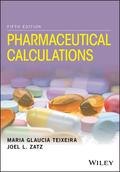Pharmaceutical Calculations

5. Edition April 2017
560 Pages, Softcover
Textbook
Short Description
Retaining the successful previous editions' programmed instructional format, this book improves and updates an authoritative textbook to keep pace with compounding trends and calculations. In order to better assist students, faculty, and professionals; the 5th edition includes a new chapter on chapter dedicated to practical calculations used in contemporary compounding, new appendices, and solutions and answers for all problems. It addresses real-world calculations practicing pharmacists perform and allows students to learn at their own pace through its heavy use of examples - connecting well with the current emphasis on self-directed learning in pharmacy schools.
Retaining the successful previous editions' programmed instructional format, this book improves and updates an authoritative textbook to keep pace with compounding trends and calculations - addressing real-world calculations pharmacists perform and allowing students to learn at their own pace through examples.
* Connects well with the current emphasis on self-paced and active learning in pharmacy schools
* Adds a new chapter dedicated to practical calculations used in contemporary compounding, new appendices, and solutions and answers for all problems
* Maintains value for teaching pharmacy students the principles while also serving as a reference for review by students in preparation for licensure exams
* Rearranges chapters and rewrites topics of the previous edition, making its content ideal to be used as the primary textbook in a typical dosage calculations course for any health care professional
* Reviews of the prior edition: "...a well-structured approach to the topic..." (Drug Development and Industrial Pharmacy) and "...a perfectly organized manual that serves as a expert guide..." (Electric Review)
CHAPTER 1 REVIEW OF BASIC MATHEMATICAL PRINCIPLES 1
1.1. Significant Figures 2
1.2. Rounding Off 4
1.3. Fractions 5
1.4. Exponents and Powers 8
1.5. Estimation 10
1.6. Units 12
1.7. Ratio 15
1.8. Proportion 15
1.9. Dimensional Analysis 18
Practice Problems 21
CHAPTER 2 SYSTEMS OF MEASUREMENT 31
2.1. Metrology 31
2.2. The Metric System 32
2.3. The English Systems 33
2.4. Measurement of Weight 33
2.5. Measurement of Volume 38
2.6. Measurement of Length 41
2.7. Intersystem Relationships 43
2.8. Household Equivalents and Metric Estimation 44
Practice Problems 49
CHAPTER 3 PRESCRIPTIONS AND MEDICATION ORDERS 54
3.1. Prescribing Authority 55
3.2. Components 57
3.3. Practices To Prevent Medication Errors 58
3.4. Common Abbreviations 60
3.5. Outpatient Prescription Drug Orders 69
3.6. Inpatient Medication Orders 72
3.7. Interpretation 77
3.8. Calculations To Check "DEA" Numbers 77
3.9. Reducing and Enlarging Formulas 80
3.10. Parts Formulas 87
Practice Problems 90
CHAPTER 4 WEIGHING AND MEASURING IN PHARMACY PRACTICE 103
4.1. Measurement Errors 103
4.2. Indication of Error 104
4.3. Tolerance In Prescription Compounding and Pharmaceutical Manufacturing 108
4.4. Weighing and Measuring 109
4.5. Aliquot Method and Triturations 119
4.6. Density 142
4.7. Specific Gravity 144
Practice Problems 145
CHAPTER 5 DOSAGE CALCULATIONS 160
5.1. Calculations Involving Dose, Size, Number of Doses, Amount Dispensed, and Quanity of a Specific Ingredient in a Dose 161
5.2. Dosage Measured By Drops 169
5.3. Dosage Based on Body Weight 171
5.4. Dosage Based on Body Surface Area (BSA) 174
5.5. Pediatric and Geriatric Dose Calculations 181
5.6. Chemotherapy Dose Calculations 184
Practice Problems 187
CHAPTER 6 DRUG CONCENTRATION EXPRESSIONS 203
6.1. Concentration 204
6.2. Percentage Strength Expressions 204
6.3. Stock Solutions, Concentrates, and Triturations 218
6.4. Saturated Solutions 222
6.5. Ratio Strength Expressions 224
6.6. Other Pharmaceutical Expressions of Drug Concentration 230
Practice Problems 235
CHAPTER 7 DILUTION AND CONCENTRATION 257
7.1. Problem-Solving Methodologies 258
7.2. So, Which Method Should I Use? 291
Practice Problems 296
CHAPTER 8 ISOTONICITY 310
8.1. Principles 310
8.2. Sodium Chloride Equivalent Values 312
8.3. Isotonicity by the Sodium Chloride Equivalent Method 315
8.4. Other Tonicity Agents 319
8.5. Isotonicity When One Ingredient is Already Isotonic 321
8.6. Isotonic Buffered Solutions 323
8.7. Other Methods 326
8.8. Determination of the Tonicity of a Solution (Hypotonic, Isotonic, or Hypertonic) 329
Practice Problems 330
CHAPTER 9 DOSAGE CALCULATIONS OF ELECTROLYTES 340
9.1. Molarity and Molality 341
9.2. Electrolyte Dissociation, Valence, Equivalent, and Equivalent Weight 344
9.3. Milliequivalents, mEq/mL, mEq/L 347
9.4. Osmolarity (Osmolar Strength) 354
Practice Problems 366
CHAPTER 10 CALCULATIONS FOR INJECTABLE MEDICATIONS AND STERILE FLUIDS 378
10.1. Reconstitution of Dry Powders 378
10.2. Calculations Related to Units/ml (Insulin, Heparin) and Other Units of Potency 386
10.3. Intravenous Admixtures 392
10.4. Extemporaneous IV Fluids 395
10.5. Flow Rates in Intravenous Sets 397
Practice Problems 399
CHAPTER 11 ENTERAL AND PARENTERAL NUTRITION 413
11.1. Screening and Assessment of Nutritional Needs 414
11.2. Enteral Nutrition 416
11.3. Parenteral Nutrition (PN): 2-in-1 and 3-in-1 Formulations 418
11.4. Calculation of Nutritional Requirements 420
11.5. Calculations for Compounding Parenteral Nutrition 429
11.6. Calculations Related to the Design of a PN 444
Practice Problems 446
CHAPTER 12 MISCELLANEOUS PRACTICAL CALCULATIONS IN CONTEMPORARY COMPOUNDING 458
12.1. Compounding with Manufactured Dosage Forms 459
12.2. Suppository Calculations 465
12.3. Determination of Amount of Base/powder Occupied by the Drug(s): Solid Dosage Forms 466
12.4. Lozenges and Lollipops 479
12.5. Selecting a Capsule Size 480
12.6. Primary Emulsion Calculations (4:2:1 Ratio) 485
12.7. A Little Touch of Veterinary Compounding 487
Practice Problems 489
APPENDICES 499
APPENDIX 1 Systems of Measurement 500
APPENDIX 2 Chemical Elements and Atomic Weights 502
APPENDIX 3 Calibration of Medicinal Dropper 503
APPENDIX 4 Solutions Used to Compound PN 504
APPENDIX 5 Conversions: Temperature, Time, Proof Strength 507
APPENDIX 6 HLB System 511
APPENDIX 7 Drug as a Base Versus Salt or Ester 514
APPENDIX 8 pH, Buffers, and Buffer Capacity 517
APPENDIX 9 Normal Concentration 525
APPENDIX 10 Biologics for Immunization 527
LITERATURE CONSULTED 529
INDEX 531
Joel L. Zatz, PhD, is Professor Emeritus at Rutgers University, New Jersey.


